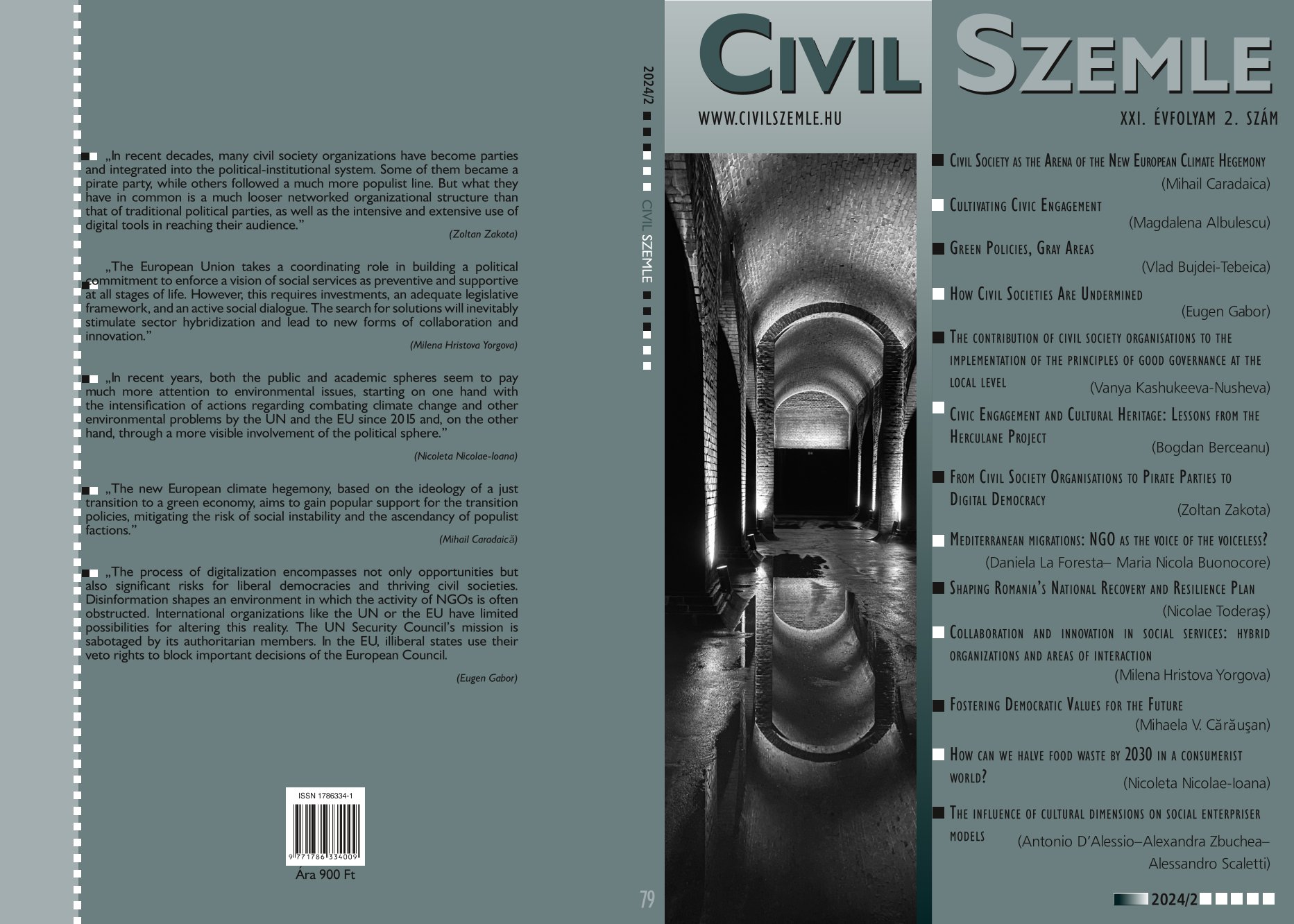Civic Engagement and Cultural Heritage
Lessons from the Herculane Project
Absztrakt
In the current global context, the cultural sector faces various challenges related to funding, access, and participation. This paper aims to identify potential pathways for civic initiatives. The purpose of this narrative article is to discuss the role of civic engagement in protecting cultural heritage goods when public authorities fail to do so. The Romanian Law of Preserving Cultural Monuments is central to this discussion. It delineates the responsibilities of both governmental and non-governmental entities in safeguarding the nation's cultural heritage. Thus, the Herculane Project- situated in Băile Herculane (Herculane Baths), initiated by a Romanian non-governmental organization (NGO) offers invaluable lessons on the dynamics between civil society, public administration authorities, and the preservation of cultural monuments. The work presents a qualitative analysis of the mechanisms through which civic engagement has influenced the trajectory of the Herculane Project. It explores how local communities, NGOs, and grassroots movements have mobilized to advocate for the preservation of Băile Herculane's cultural heritage. The conclusion of this paper aims to demonstrate the relevance of contemporary civil societies in preserving cultural heritage goods. It underlines how the best practices employed by the NGO in charge of the Herculane Project can be applied to other cases while considering the dynamics of cultural heritage preservation.
Hivatkozások
Albu Ioana and Zak ota Zoltan (20 22): The Ev olution of Civil Society in P ost-December Romania. Civil Szemle/Civil Review, Special Issue 3.– Romanian D iagnoses: pp. 205–217.
Bertacchini, Enrico (2020): Urban Heritage as Cultural Capital, District, and Commons: An Economic Perspective. In: Macrì, Emanuela–Morea, Valeria–Trimarchi, Michele (Eds.): Cultural Commons and Urban Dynamics a Multidisciplinary Perspective. Switzerland: Springer Nature. pp.11–24.
Borchi, Alice (2020): Towards a Policy for the Cultural Commons. In: Macrì, Emanuela–Morea, Valeria–Trimarchi, Michele (Eds.): Cultural Commons and Urban Dynamics. A Multidisciplinary Perspective. Switzerland: Springer Nature. pp. 11–24.
Duxbury, Nancy–Hosagrahar, Jyoti–Pascual, Jordi (2016): “Why must culture be at the heart of sustainable development?”. Barcelona UCLG (https://estudogeral.uc.pt/) pp. 1–36.
Gravagnuolo, Atonia–Micheletti, Serena–Bosone, Martina (2021): A Participatory Approach for “Circular” Adaptive Reuse of Cultural Heritage. Building a Heritage Community in Salerno, Italy. Sustainability, 13., 4812, doi: https://doi.org/10.3390/su13094812.
Haque, M. Shamsul–Baker, John (2006): Role of Civil Society Organizations in Governance: Theoretical Perspectives. International Journal of Business and Management, 2., (1.), pp. 14–21.
ICOMOS (2011): Guidance on Heritage Impact Assessments for Cultural World Heritage Properties: Paris. Available online: https://www.iccrom.org/
Martin, Eloisa (2014): How to write a good article. Current Sociology, 62., (7.), pp. 949–955. doi:
https://doi.org/10.1177/001139211455603.
McCandlish, Alison–McPherson, Gayle (2021): Promoting tangible and intangible hidden cultural heritage: local communities influencing civic decision-making and international cultural policy. International Journal of Cultural Policy, 27., (5.), pp. 683–698, doi: https://10.1080/10286632.2020.
Munteanu, Florea Ionela–Mirea, Marioara–Susu, Cosmin (2020): Public Governance and Cultural Heritage: Exploring the Links between Culture and Social Indicators with the Principal Component Analysis. In: Turcanu-Carutiu, Daniela (Ed.): Heritage, Rijeka: IntechOpen: https://doi.org/10.5772/intechopen.90793.
Nilson, Tomas–Thorell, Kristina (Eds.) (2018): Cultural Heritage Preservation: The Past, the Present and the Future. Halmstad: Halmstad University Press. DiVA id: diva2:1224014.
Polgár, István József (2023): The Role of Civil Society Organisations in Migration Management. Cooperation between Public Authorities and Civil Society Actors at the EU’s South Eastern Borders. Civil Szemle/Civil Review, Special Issue 4., pp. 27–40.
Rigney, Ann (2016): The Afterlives of Walter Benjamin: Theodor Adorno on The Work of Art and Cultural Heritage. In: Wulf, Ciraj Rassool–Rigney, Ann (Eds.): Sharing the Past: The Reinvention of Memory in South African and Israeli Museums. New York: Berghahn Books. pp. 24–49.
Rodzi Nur, Izzati Mohd–Zaki, Saniah Ahmad–Subli, Syed Mohd Hassan (2013): Between Tourism and Intangible Cultural Heritage. Procedia-Social and Behavioral Sciences, 85., pp. 411–
https://doi.org/10.1016/j.sbspro.2013.08.370.
Thorne, Sally E. (2014): Applied Interpretive Approaches. In: Leavy, Patricia (Ed.): The Oxford Handbook of Qualitative Research. New York: Oxford University Press. pp. 99–115, doi: https://doi.org/10.1093/oxfordhb/9780199811755.001.0001 .
UN (2016): Sustainable Development Goal 11. Sustainable Development Goals. Available online: https://sustainabledevelopment.un.org/sdg11.
UNESCO (2020): Recommendation on the Historic Urban Landscape, Including a Glossary of Definitions.
Available online: https://whc.unesco.org/uploads/activities/documents/activity-638-98.pdf
UNESCO Institute for Statistics (2009): UNESCO Framework for Cultural Statistics. Available online: https://uis.unesco.org/en/glossary-term/cultural-heritage.
Žuvela, Ana–Šveb, Dragija Marta–Jelinčić, Daniela Angelina (2023): Partnerships in Heritage Governance and Management: Review Study of Public–Civil, Public–Private and Public–Private–Community Partnerships. Heritage, 6., pp. 6862–6880. doi: https://doi.org/10.3390/heritage6100358.
UNESCO (1972): Convention Concerning the Protection of the world Cultural and Natural Heritage. Available online: https://whc.unesco.org/en/conventiontext/
Regulations
Regulation (EU) 2019/880 of the European Parliament and of the Council of 17 April 2019 on
the introduction and the import of cultural goods, Official Journal of the European Union,
OJ L 151, 7.6.2019: 1–14.
Council Regulation (EC) No 116/2009 of 18 December 2008 on the export of cultural goods (Codified
version). Official Journal of the European Union, L 39, 10 February 2009.
Law no. 422/2001 regarding the protection of historical monuments was published in the Official
Gazette of Romania, Part I, no. 407 of July 24, 2001, republished pursuant to art. V from
Law no. 259/2006 for the amendment and completion of Law no. 422/2001 regarding the
protection of historical monuments, published in the Official Gazette of Romania, Part I, no.
of J uly 3, 2006, giving the texts a new n umbering.
Weblinks
Europa Nostra: https://www.europanostra.org/, last accessed: 7.04.2024.
Heculane Project: https://herculaneproject.ro/, last accessed: 7.04.2024.
Institutul Național al Ptrimoniului/ the National Institute for Cultural Heritage: https://patrimoniu.ro/ro//articles/lista-monumentelor-istorice, last accessed: 6.04.2024.
Institutul Național de Statistica/ National Statistical Institute: http://statistici.insse.ro:8077/tempo-online/#/pages/tables/insse-table: 7.04.2024.
Primăria Orașului Băile Herculane/Town Hall of Băile Herculane: https://www.primaria-baileherculane.ro/statiunea-baile-herculane, last accessed: 6.04.2024.
https://7mostendangered.eu/, last accessed: 4.04.2024.



